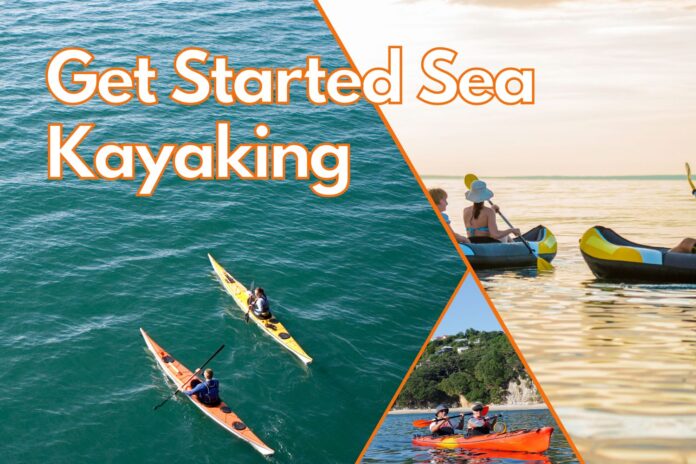The sea kayak offers up so much than the sum of its parts.
Maybe it’s because we’re a nation of island dwellers and the call of the sea is ingrained upon our souls, after all did you know that no matter where you are in the UK you are never more than about eighty miles from a coastline?
Or maybe it’s because the sea kayak offers us a very special kind of freedom.
Launch out from the shore and you are instantly master of your own boat and have access to a very different perspective on the wild nature that now surrounds you and the stunning shores and coastlines that present themselves to you at every dip of the paddle.
Getting Started
Whatever your motivation to get out in a sea kayak, the sea is a changeable and dynamic environment, so you’ll need to be fully prepared.
Part of the excitement of the sea is just how quickly it can change from a dead-calm millpond to a raging, rough maelstrom, so good planning, knowing your limits and a solid understanding of the weather and environment is key.
Even if you’re just heading out for a short paddle around a sheltered bay it’s still a wise move to get in to the habit of checking the weather reports and tide times beforehand.
It is a really good idea to attend a basic sea kayaking course and there are a great many specialist sea kayaking schools around the UK that provide courses in navigation, the effects of weather and how to counteract them, and how to interpret tides and plan a trip to fit around them.
Once you’ve added these to your bag of sea kayaking paddling skills you’ll be set to start exploring the sea to your heart’s content.
Sea Kayak Clubs
Another great way to get started is to join a club.
Most clubs will contain at least a couple of salty sea dogs who can take you on trips that you couldn’t plan yourself, there may also be kayaks that you can try out, and there will be lots of people eager to share their enthusiasm for this very special branch of the sport.
Set a Course for Adventure
A sea kayak can take you to the most remote corners of the earth, or it can take you a few miles up an estuary or along a beach, while the family look on.
You can gently slice through mirror flat water, or surf on crashing standing waves in a tidal race! You don’t need to be able to plan a crossing of the English Channel to enjoy a paddle along a sheltered coastline, but whatever you do, be sensible and safe.
A calm day can change into a full-blown storm in a few hours, and an offshore wind can carry the unwary paddler far out to sea.
Around some headlands or along certain narrow channels, currents can travel faster than any kayaker can paddle, and the sea can whip up into a frenzy similar to a gushing river.
The British Canoe Union recommends that you always paddle in a group of at least three people, so that if someone gets injured, they are never left alone.
Make sure that you know how to take your spray-deck off and get out of your kayak under water, and that you know how to put a swimmer back into their kayak.
As already mentioned, you should find out the weather forecast and the tidal currents in any area that you plan to paddle and if the conditions aren’t right go somewhere else, or cancel your trip.
A local outdoor shop or centre should be able to give you advice on where to paddle.
It is also a good idea to tell the coastguard where you’re going, but don’t forget to let them know when you get back safely.
As a minimum you should at least carry water, a set of split paddles, spare warm clothes, a hot drink, emergency food, a first aid kit, a torch and a whistle.
Be aware that it’s easier to paddle into wind than it is to have the wind behind you. Don’t set off with the wind in your face if you’re not confident of paddling back with a following sea.
Look out for other boats and ferries – they often can’t stop if you are in the way.
Please don’t let these considerations put you off trying though, because in the right conditions sea kayaking is a fantastic experience that will have you developing a taste for salt and coming back for more time and time again.
There are plenty of experienced coaches or clubs that can introduce you to it safely.
What Sea Kayak is Right For You?
At their origin years ago, sea kayaks were made of a wooden frame covered with animal skin, and used mainly for hunting by Inuit peoples.
Today, most are made of composite materials or plastic.
Even the choice of colours available can be overwhelming let alone design styles.
The best thing to do is ask advice from several different people, but here are a few pointers.
As a sea paddling beginner, the best sea kayaks will depend on whether you want to go on day trips or expeditions.
Important considerations are:
- Is the kayak safe for use on the sea?
- Do you feel comfortable in it?
- Is it easy to control?
- Is it priced within your budget?
The modern day sea kayaking beginner has a multitude of stable, user-friendly sea kayaks to choose from, so they’ll be the perfect boat for your shape, size, needs out there somewhere.
As a rule, the longer and narrower the kayak, the faster it will travel, and the easier it will be to paddle in a straight line.
A long, fast kayak will often be a bit more wobbly, or as paddlers say, ‘tippy, and harder to turn, but this does depend on the shape of the hull, and even the size of the paddler.
Sometimes loading your kayak with kit can stop the wobbles, but make sure you balance the weight evenly between the front and back.
Try looking for a kayak with a low seat because the lower your centre of gravity is, the more secure you will feel.
If the backrest or the back of the cockpit rim is too high, this can also make rolling more difficult if you’ve mastered that skill.
Bulkheads & Hatches
A sea kayak should normally have separate sealed compartments at the front and back of the kayak called bulkheads.
By opening a hatch on the deck of the kayak, you can store your kit in the boat.
This can be anything from a couple of sandwiches and a flask of tea, to a tent, stove and food for a fortnight long expedition.
Most importantly, the bulkheads mean that if you capsize, water can only fill up your cockpit, making rescuing the kayak much easier and safer.
You could also make some journeys on the sea in a relatively long river kayak, but if you don’t have bulkheads then you should definitely use airbags to fill up the spaces behind your seat and footrests.
Any kayak used on the sea should also have deck-lines, which make rescues safer and easier.
Composite or Plastic?
Composite kayaks (carbon, Kevlar or fibreglass) are generally a little faster than plastic kayaks.
Of course, weights vary but a composite expedition kayak usually weighs less than a similar plastic kayak.
Then again, glass boats are more expensive and more easily damaged on sharp rocks and the designs available in plastic have come a very long way in recent years.
If you think you might have steering problems, or want to spend time ‘rock hopping’ close in to the shore then a plastic kayak might be a more sensible start.
Sea Kayaking Paddles
As a general rule, most people use a longer paddle for sea kayaking than for river paddling or surfing.
The best length of paddle and size of blade for you depends on your size and strength.
A good canoe shop should be able to advise you on what suits you best but, if you can, try out a few different paddles before you buy one.
Generally, the taller you are the longer your paddle should be, and the more powerful you are the bigger blade area you can paddle with.
Other factors you might want to consider are the weight of your paddle, the angle of feather and whether you want modified cranks.
If you don’t know what I’m talking about then maybe you shouldn’t worry about it just yet!
Lots of modern paddles come with an adjustable joint, so you can adjust the length and feather of your paddle to your need on the day.
Many sea kayakers also choose to take a spare pair of split paddles with them just in case and paddle leashes are also popular to keep this essential bit of kit close at hand while you’re at sea.
What to Wear When Sea Kayaking
What kit you wear depends on how much of the time you are likely to be sea kayaking, and how long you expect to spend swimming!
If you think you might capsize and fall in the water a lot (a possibility if you’re learning), then it’s probably best to wear a long-john wetsuit with a thermal top and a cagoule.
Avoid sleeved wetsuits because they can chaff under your arms and restrict your movement when you’re paddling.
A more expensive alternative is to opt for one of the kayaking-specific dry-suits that are now very popular.
Your thermal can be thick or thin, depending on the time of year and the weather.
Wetsuit boots, sandals or old trainers will work on your feet, but be careful that any laces or straps don’t get caught in the footrests.
Sea kayakers often don’t wear helmets, but if you are kayaking close to rocks or surfing then you should definitely protect your head.
Many sea kayaking buoyancy aids have lots of big pockets for safety equipment, sun lotion and, of course, chocolate and snacks!
If you’re confident that you won’t be swimming then you could try dry trousers and a cag, or again a dry suit.
Neck rashes and uncomfortable wrists are optional in sea kayaking, as most manufacturers make specially designed open necked cags with looser wrist seals!
Voyage of Discovery
We could speculate forever about how and what kit to use, but at the end of the day, there is no substitute for actually getting out there and having a go.
So, what are you waiting for?
Go find your nearest kayaking club, book yourself onto a course, head to the coast and go sea kayaking!




